
There are 6 photos on this page. Make sure you scroll down to see them all.
The WCAU-TV Mobile Unit
1948
(Click on the image to see a larger version of crew on roof)
WCAU-TV's Field Remote Van is a standard RCA TJ-50A Mobile Unit equipped with three camera chains, a master monitor, relay equipment and accessories.
It consisted of a one and a half ton Chevrolet chassis with a custom built van-type body with facilities for the operations of three B&W cameras. (There was no commercial color television in 1948). The length of the vehicle was 21 and a half feet, 8 feet wide with a height of 9 feet, 3 inches. The weight before equipment was 8950 pounds.
The Evening Bulletin that owned the station at that time bragged that the Mobile Unit cost $85,000. In today's dollars that would be over three quarters of a million bucks. The paper also bragged that it was the absolute latest equipment available anywhere. Referred to as "a television station on wheels", it was equipped with a traveling control room, three cameras, a sync generator and all of the "different electronic gadgets" that are necessary to telecast live from a remote location. The paper also stated: Engineers like to brag about the number of highly specialized radio tubes that it takes to perform these miracles, and they're got 309 to brag about. And since each is vitally important, there has to be a spare for each, making a grand total on hand of 618."
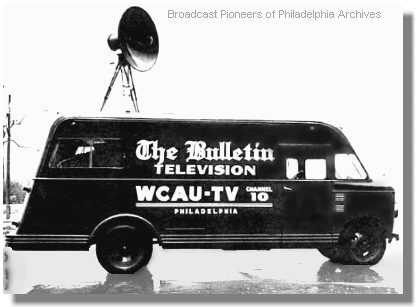
WCAU-TV Mobile Unit
March 27, 1948
The microwave transmitter was normally tripod mounted on the truck's roof, as seen in this photo. This was how the live signal was sent back to the station. It took a crew of 11 to run the operation. Five were stationed inside the vehicle, three were camera operators and three performed other duties.
A World War II surplus gasoline generator was used in conjunction with the TV Field Truck where pickups were made at points having no electricity (60 cycle AC power). This unit was mounted on a bomb trailer and generated 60 cycle 110 volts AC with a 6 KW capacity. An automatic regulator maintained the frequency at 60 cycles under varying loads. A trailer hitch had been mounted on the bomb trailer and could be attached either to the TV field truck or a station wagon for hauling.
The Bulletin also said: The biggest single problem in televising a remote pick-up is finding the right place for "the dish," the big four-foot parabolic reflector which sends the micro-wave signals from the mobile unit to WCAU-TV's main transmitter on the PSFS Building. The dish, when possible, is set atop the truck, but since micro-waves follow a straight line-of-sight, it has to be placed within sight of the tower of the main transmitter."
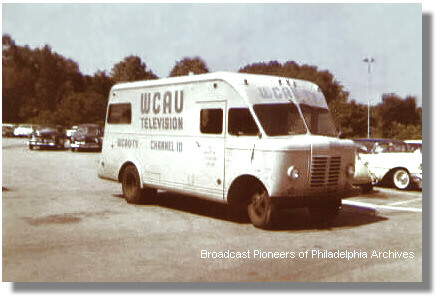
WCAU-TV Mobile Unit
September 1958
Note that this is the same truck. It has simply been repainted. This photo was taken by Broadcast Pioneers member Charlie Higgins right after CBS took over the WCAU stations. Charlie e-mailed, ...I had backed it out of the garage specifically to take the photo. We had a bigger remote truck when CBS bought the station which was later given to Villanova University sometime after 1965. ...If you could read what it says on the door of the truck it says "The Philadelphia Bulletin Station". There is no mention of CBS on the truck.
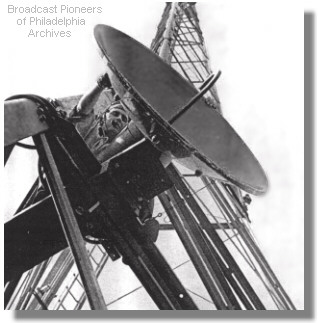
WCAU-TV Relay Receiver on the PSFS Building (1948)
WCAU-TV transmitter technician John Bolmarcich adjusting the parabolic reflector, part of the microwave relay system which enabled the station to send television broadcasts to the tower atop the PSFS Building without cable connection.
WCAU-TV's exceptionally high tower was an "ideal location" for their RCA TRR-1A relay receiver used to pick up video and audio signals from the mobile unit. The parabola was mounted so that it could be oriented through a wide angle. Other positions provided pickup from all directions in the area. This was on top of the PSFS (Philadelphia Savings Fund Society) building in Center City Philadelphia. At the time, it was the tallest office building in the city, almost 500 feet high. The tower and antenna were 256 feet high, giving the building and antenna a total height of 737 feet. It was located at 12th and Market and the WCAU studios were at 1622 Chestnut Street. Signals from this were sent via permanent land lines from the PSFS roof to the WCAU signals, a few blocks away.
In the summer of 1946, The Evening Bulletin and station officials held long and thoughout conferences with engineers and technicians to determine how the best pictures could be broadcast. They believed that the highest possible transmitter tower site was best, since TV travels by line of sight and that meant that the higher the transmitter tower, the farther and wider would be the area covered.
After much study, the roof of the Philadelphia Savings Fund Society Building was decided upon as the ideal location. The transmitter was constructed on the top floor of the building and the tower erected on its roof. The top of the antenna system was 200 feet taller than the top of William Penn's hat on top of Philadelphia's City Hall.
At that time (1948), WCAU-TV used a power of 25 kilowatts operating on Channel 10 (192 to 198 megahertz). It was granted its construction permit on September 30, 1946 and aired the first test pattern on March 1 of 1948.
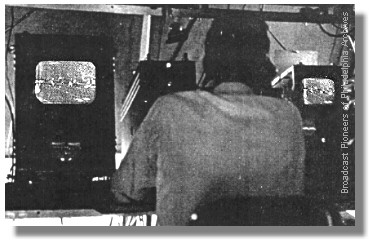
Inside WCAU-TV Mobile Unit
late 1948
This was the operating position in the WCAU-TV Mobile Unit during the live pickup of a night football game. You can actually see the game play in the monitors.
Located in the rear of the truck, a tilted shelf supported this field master monitor, field siwtcher unit, three camera control units, and an OP-6/OP-7 audio amplifier and mixer which had provisions for four mikes. Beneath the shelf, on the floor, were located the two units of the field synchronizing generator, and four power supplies for the cameras and switcher. On a smaller shelf, above the video and audio control equipment, an RCA 630TS receiver was mounted for on-the-air monitoring. Beside this receiver, the TTR-1A microwave transmitter control unit was mounted within easy reach of the video control operator.
The "heart" of the unit was a band of three camera controls in a row over the table in the rear of the truck. Each control was connected by cable with a field camera. Each were set up to get a different view and angle of whatever action was being televised and each control panel had its own screen showing the picture from each camera. Each camera operator wore headsets and microphones and communicated with the mobile unit's control room.
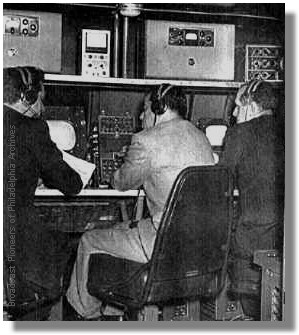
Audio Engineer, Producer and Video Control Operator
April 7, 1949
By the way, Tony Verna, long-time Producer at WCAU-TV, said that he feels the Video Technician on the right is "Robbie" Robertson. He then added that Robbie's last name may be Robinson. Fred "Skeets" O'Neill, a long-time director at Channel 10 e-mailed I believe the name you refer to is Charlie Robinson, a favorite with all the Techs. Robbie was a tech superviser easily recognized by the clipboard constantly at his side. Robbie was sometimes known as 'Mr. Nice Guy."
The producer's location was near the middle of the shelf and facing the rear. On his left was the audio tech, and on his right was the video control person.
The producer kept in constant touch with all three camera operators. Watching the images in the three camera control screens, he could direct the work of the camera people and have the video switched instantly from one camera to another to give the best possible view of the action.
There was also an Assistant Producer on hand to help out. The "AP" was usually outside the truck near the cameras. For example, if the truck was televising a sumphony orchestra concert, the Assistant Producer would follow the score and give warnings to the Producer that a violin solo would be coming up in eight bars. In that way, the camera operator could be directed to get a shot of the solo when it happened. At football games, a spotter was on hand to help the camera operators follow the ball. Similarly, when live news coverage was done, the "AP" job was to follow any schedule and to foresee developments in order that the camera crew could have enough time to get each important step inside the range of their view finders.
Six cable reels with a capacity for 200 feet of camera cable were mounted between the video equipment and the rear doors of the vehicle. On both sides of the truck's interior, cabinets were placed to store cameras, tripods, lenses, lighting and other equipment. Between the cabinets on the left side and the video person, was a voltage regulator with a rating of 5 KW, and it was mounted on a shelf. This unit provided communication to any Bell Telephone so long as the truck was within range of a radio telephone receiving point.
From the official archives of the Broadcast Pioneers of Philadelphia
Text compiled and researched by Broadcast Pioneers member Gerry Wilkinson
B&W pictues, #1, #3 and #4 originally donated by Broadcast Pioneers member Allen Murphy
B&W Photos, #2 and #5, originally donated by Broadcast Pioneers member Gerry Wilkinson
Color photo originally donated by Broadcast Pioneers member Charlie Higgins
All Rights Reserved
The e-mail address of the Broadcast Pioneers of Philadelphia is pioneers@broadcastpioneers.com